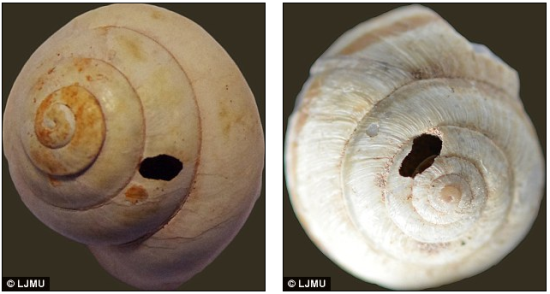Sarah Griffiths
Source - http://www.dailymail.co.uk/sciencetech/article-3279233/Early-man-dined-SNAIL-PORRIDGE-Molluscs-menu-150-000-years-ago-special-drills-used-extract-meat-shells.html#ixzz3p1oGyiMB
Prehistoric man dined on SNAIL PORRIDGE: Molluscs were on the menu at least 150,000 years ago and special 'drills' were used to extract the meat from shells
Whether dripping in garlic butter or served in Heston Blumenthal’s vivid green porridge, land snails are considered a gourmet treat.
But academics have discovered the succulent molluscs were also on the menu at least 150,000 years ago.
Snail shells discovered in a Libyan cave suggest early humans used stone ‘drills’ or thorns to extract the molluscs from their shells.
 Holes made in snail shells (pictured left and right) that were discovered in a Libyan cave, suggest early humans used stone ‘drills’ or thorns to extract snails from their shells so they could eat them more easily
Holes made in snail shells (pictured left and right) that were discovered in a Libyan cave, suggest early humans used stone ‘drills’ or thorns to extract snails from their shells so they could eat them more easily
Archaeologists from Liverpool John Moores University (LJMU), Queen’s University Belfast and the University of Cambridge discovered ancient people in North Africa pierced land snail shells with specially-selected tools to make them easier to eat.
Lead author, Dr Evan Hill, who conducted the mollusc work during his postgraduate studies at Queen’s University Belfast, explained: ‘As part of the analysis of archaeological material from the excavation of the Haua Fteah Cave in Libya, tens of thousands of mollusc shells were studied for both palaeoclimate reconstruction and high resolution radiocarbon dating.
 Haua Fteah Cave
Haua Fteah Cave
‘While studying these shells, we saw damage on many specimens that was consistent with human action.
‘We also found a number of stone artefacts that showed evidence of use as drills.
‘Detailed analysis of the pierced shells at Queen’s University Belfast and LJMU and of the stone tools at the University of Cambridge by my colleagues Dr Giulio Lucarini and Dr Giuseppina Mutri suggests that molluscs were consumed by people at the Haua Fteah over at least 150,000 years.’
Dr Chris Hunt, Reader in Geography at LJMU said experts have suspected for some time that early people ate snails and that they were an everyday snack.
‘It has been very difficult to be sure, but our observations of piercing in shells up to 150,000 years old shows that this went on.
‘The piercing broke the suction that makes the animals difficult to extract, letting people suck them right out of the shell – not nice in my view!
‘Snails seem to have been a very democratic thing for early people to eat, because anyone could gather them.
‘They seem to have been widely eaten when times were hard, whereas today they are a luxury item.’
He told MailOnline that snails were particularly common in layers of the cave between 14,000 and 10,000 years ago.
'These people certainly ate a lot of snails, but they also ate plant foods including pine nuts, wild fruits, and seeds of wild plants and animals including Barbary sheep, tortoises and antelopes.
'We think people were pretty short of food at this time. They seem to have been so short of food around 10,000 years ago that they had to gather even really small snails.
'Small shells are rather difficult to gather and you don't get much food value from them so people only do it when they are desperate.'
At other times, snail, animal and plant remains were less common, probably because there were less people around, he explained.
'The snails in the oldest part of the cave sequence are pretty unusual because archaeologists have not reported evidence like this before at this time, Dr Hunt added.
'There are also animal bones in these layers, mainly of Barbary sheep, but we don't have evidence of plant foods. We are not sure why this is , but it may be because they don't survive.'
HAUA FTEAH CAVE, LIBYA
The large cave on the north coast of Libya was discovered in 1948 by a Cambridge professor.
He discovered layer upon layer of evidence of human occupation going back around 80,000 years, according to a blog post.
He said human jaws found at the site indicated modern humans, or Homo sapiens, arrived in Europe 40,000 years ago - an idea that has has now been revised.
In 2007, excavations resumed and now experts believe the site is far older than first thought, potentially stretching back 200,000 years.
They have previously established one layer of the cave dates back 90,000 years and now the discovery of the snail shells pushes proof of occupation back much further to 150,000 years ago.
The team is looking for evidence of 'modern' behaviours and evidence of the people’s technologies and hunting practices.